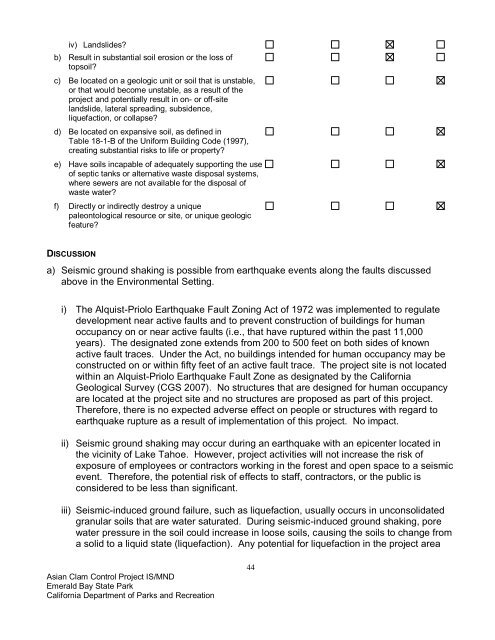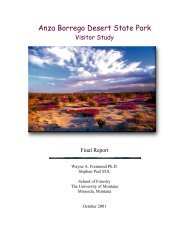Final Mitigated Negative Declaration and Response to Comments
Final Mitigated Negative Declaration and Response to Comments
Final Mitigated Negative Declaration and Response to Comments
You also want an ePaper? Increase the reach of your titles
YUMPU automatically turns print PDFs into web optimized ePapers that Google loves.
iv) L<strong>and</strong>slides?<br />
b) Result in substantial soil erosion or the loss of<br />
<strong>to</strong>psoil?<br />
c) Be located on a geologic unit or soil that is unstable,<br />
or that would become unstable, as a result of the<br />
project <strong>and</strong> potentially result in on- or off-site<br />
l<strong>and</strong>slide, lateral spreading, subsidence,<br />
liquefaction, or collapse?<br />
d) Be located on expansive soil, as defined in<br />
Table 18-1-B of the Uniform Building Code (1997),<br />
creating substantial risks <strong>to</strong> life or property?<br />
e) Have soils incapable of adequately supporting the use<br />
of septic tanks or alternative waste disposal systems,<br />
where sewers are not available for the disposal of<br />
waste water?<br />
f) Directly or indirectly destroy a unique<br />
paleon<strong>to</strong>logical resource or site, or unique geologic<br />
feature?<br />
DISCUSSION<br />
a) Seismic ground shaking is possible from earthquake events along the faults discussed<br />
above in the Environmental Setting.<br />
i) The Alquist-Priolo Earthquake Fault Zoning Act of 1972 was implemented <strong>to</strong> regulate<br />
development near active faults <strong>and</strong> <strong>to</strong> prevent construction of buildings for human<br />
occupancy on or near active faults (i.e., that have ruptured within the past 11,000<br />
years). The designated zone extends from 200 <strong>to</strong> 500 feet on both sides of known<br />
active fault traces. Under the Act, no buildings intended for human occupancy may be<br />
constructed on or within fifty feet of an active fault trace. The project site is not located<br />
within an Alquist-Priolo Earthquake Fault Zone as designated by the California<br />
Geological Survey (CGS 2007). No structures that are designed for human occupancy<br />
are located at the project site <strong>and</strong> no structures are proposed as part of this project.<br />
Therefore, there is no expected adverse effect on people or structures with regard <strong>to</strong><br />
earthquake rupture as a result of implementation of this project. No impact.<br />
ii) Seismic ground shaking may occur during an earthquake with an epicenter located in<br />
the vicinity of Lake Tahoe. However, project activities will not increase the risk of<br />
exposure of employees or contrac<strong>to</strong>rs working in the forest <strong>and</strong> open space <strong>to</strong> a seismic<br />
event. Therefore, the potential risk of effects <strong>to</strong> staff, contrac<strong>to</strong>rs, or the public is<br />
considered <strong>to</strong> be less than significant.<br />
iii) Seismic-induced ground failure, such as liquefaction, usually occurs in unconsolidated<br />
granular soils that are water saturated. During seismic-induced ground shaking, pore<br />
water pressure in the soil could increase in loose soils, causing the soils <strong>to</strong> change from<br />
a solid <strong>to</strong> a liquid state (liquefaction). Any potential for liquefaction in the project area<br />
Asian Clam Control Project IS/MND<br />
Emerald Bay State Park<br />
California Department of Parks <strong>and</strong> Recreation<br />
44
















